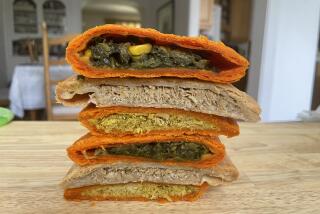Weekly Dance Keeps Fishing Village Jumping
- Share via
CASTRIES, St. Lucia — Every Friday evening, locals and visitors on this Caribbean island get together in the little fishing village of Gros Islet for a “jump up,” a free-wheeling street dance complete with calypso and reggae bands, barbecue, rum drinks and a carnival atmosphere.
The fun began about five years ago when a rum shop began to ladle out music and barbecue with its potions. Other bars and restaurants soon joined in with their own bands, and what started as an impromptu affair has grown steadily into a popular weekly event.
Gros Islet’s jump up is a perfect example of the relaxed friendliness and good spirits of St. Lucians, whose island gained full independence as a member of the British Commonwealth in 1979.
Whether Columbus did or did not land here on one of his voyages isn’t really important to today’s visitor. What is important can be found by anyone seeking a small and unspoiled island, tropical flowers and fruit in abundance, scores of uncrowded beaches and coves, plus weather to make one forget the wet lash of winter back home.
Getting here: Fly American, Delta or Eastern to San Juan, Puerto Rico, then American Eagle on to St. Lucia’s Vigie Airport in Castries. American and other airlines fly into larger Hewanorra Airport 40 miles south.
How long/how much? It doesn’t make much sense to stay less than a week, and some stretch it much longer. Lodging costs are moderate in summer, creeping up from Christmas to April-May.
A few fast facts: The local dollar is worth about 38 cents U.S. Temperatures hover in the 70s and 80s all year, but humidity can make afternoons rather sultry. Hurricane Hugo left no marks on St. Lucia.
Getting settled in: Halcyon Beach Club (three miles from Castries; $140 to $160 double, winter; $100-$125 summer) on the west coast overlooks a beautiful, palm-fringed beach. It’s a huge place with spacious lawns and gardens, and vines with lavender flowers or bougainvillea crowning each unit’s veranda. There’s a pool, open-air restaurant, children’s playground with supervision and a wharf with yet another restaurant.
The Islander (Rodney Bay; $95 double, winter, $65 summer) has 40 doubles, plus 20 one-bedroom studios with kitchens ($105 winter, $70 summer). Like the Halcyon, children under 12 stay free. While the Islander has the open and airy feeling of most hotels here, it’s not on the beach, though a van takes guests there. It has a half-pension plan for $22, $18 for children, as well as a terrace bar and restaurant by a large pool ringed with hibiscus.
The St. Lucian (seven miles from Castries at Reduit Beach; $190 B&B; double, winter; $105 summer) has about everything a St. Lucian hotel can offer. There’s a fine beach, two excellent restaurants that won almost every ribbon in a recent competition with other island hotels, three bars, tennis courts, a dive shop, windsurfing, evening entertainment and a live band for dancing, plus a disco.
Regional food and drink: When asked about island food, a native said: “Dumplings, crab and callaloo is all you need to know.” We had trouble finding the dumplings, which are usually served at home, but crab and the delicious callaloo (a spinach-like green) were on every menu.
Another delectable discovery was creamed chrystophene, a hot or cold soup made with a white, squash-like fruit. The chilled version is much better than vichyssoise. Pumpkin soup, hot or cold, is another delicious island staple.
Caribbean and Atlantic seafood (tuna, kingfish, prawn, octopus, lobster) take their rightful place on the table, often given a curry or creole treatment common on the island. You’ll also find a lot of breadfruit, banana bread and plantains.
Heineken beer is brewed here, but we still prefer Jamaica’s Red Stripe, available everywhere.
Good dining: The Lime (Rodney Bay) is an open and very bright place where the accent is on creole dishes, fish and chicken. There’s the after-work crowd that stops by for a cooler, another crowd for candlelight dinners and a third that hangs on well into the night.
Rain (Columbus Square, Castries) takes its name from the Somerset Maugham story, and the green-and-white gingerbread Victorian at town center almost outdoes Maugham’s tales for color. Have lunch on the patio under a mango tree or dinner on an upstairs balcony overlooking the square. The menu runs the course of island fare, with late entries scribbled on a blackboard.
Combine an hour’s boat trip (four hours by car) to the town of Soufriere on the southwest coast and lunch at Anse Castenet, a wide-open restaurant on the beach that keeps a grill going with brochettes of beef, fish, prawn and chicken. The house specialty is beef Maniere Mama Moi, made with sweet and hot peppers, garlic and cinnamon. Delicious.
Going first-class: Hotel La Toc (Vieux Fort, three miles from Castries, $215-$250 double, winter; $140-$175, summer-fall) is owned and operated by the Cunard shipping people. It’s sheer elegance from bow to stern. Set on 110 wooded acres beside a pristine beach, La Toc’s rooms are gorgeous.
They also have 54 individual villa-suites on a hill overlooking the sea ($350-$500 double, depending on season and location), many with private pool on the deck.
La Toc’s Les Pitons dining room, named for the twin peaks that are a St. Lucia landmark, is presided over by a Michelin two-star chef, and that just about says it all for the fine food.
Yet until we find a better one, San Antoine (on a hill above Castries Harbor) gets our vote as the Caribbean’s very best and most romantic restaurant. A former private home and later a hotel, it caught fire in 1970. Only the thick stone walls, arches and stairwells survived, but the building has been fully restored.
For the meal nonpareil, try the fruits de mer en papillote , prawns in a Pernod sauce, crayfish with garlic butter or filet au poivre vert .
On your own: Start with a turn through Castries, where your first concern is deciding which is more colorful, the market or cathedral. The former, very Victorian and painted fire-engine red, spills onto surrounding streets of curbside vendors hawking the fruit, flowers and vegetables of the island. The cathedral, meanwhile, has an interior that is a vibrant rainbow of color and native art.
Getting about the island (27 by 14 miles) isn’t all that easy by car. So why not take a boat from Castries down to Soufriere for a look at Les Pitons? The Unicorn, a 140-foot brig with 6,000 square feet of sail, makes the run daily, and features a steel band, rum punch, fried chicken and other enticements.
For more information: Call the St. Lucia Tourist Board at (212) 867-2950, or write (820 2nd Ave., 9th Floor, New York 10017) for brochures on the island, including a map.
More to Read
Sign up for The Wild
We’ll help you find the best places to hike, bike and run, as well as the perfect silent spots for meditation and yoga.
You may occasionally receive promotional content from the Los Angeles Times.






